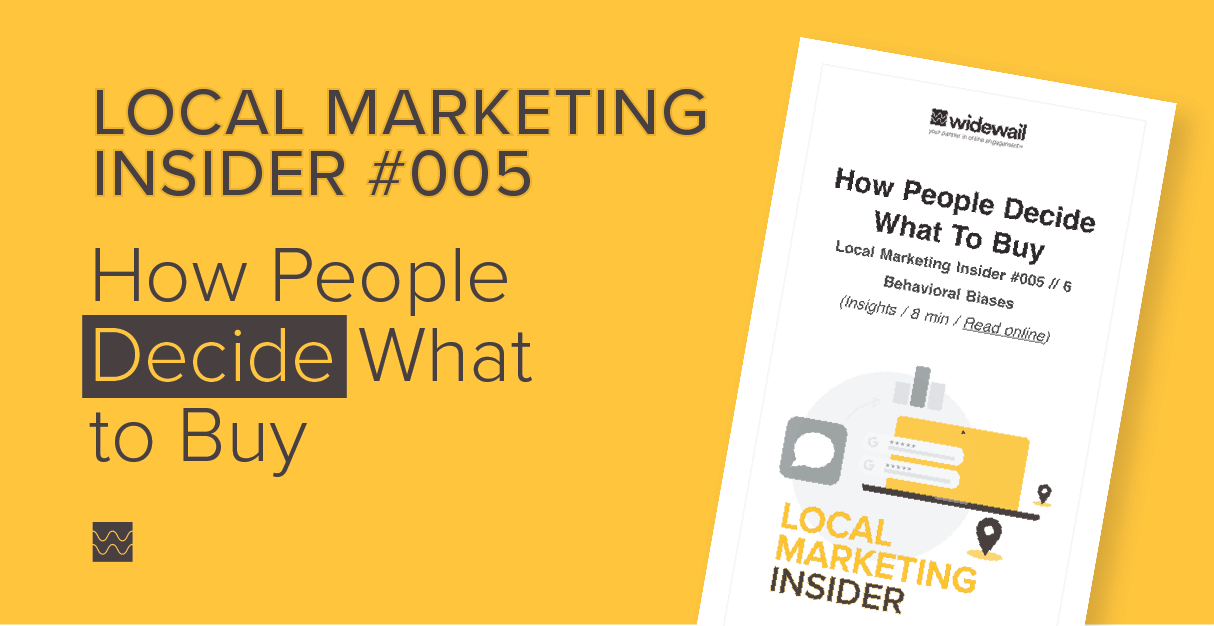-
Products
TechnologyManaged Services
- Resources
- Pricing
- Company
We explore the 6 behavioral biases (i.e. the 6 shortcuts shoppers use to make a buying decision easier, and how you can use them in your marketing).

Even at 94 pages, I couldn’t put this report down.
Earlier this year Google put out a report looking at the influence of behavioral science biases on brand preference.
It’s a great article and I highly recommend you read it in full, but I’m here today to distill down what I think are the most important points for the local marketer to consider.
To start, I'll outline the 6 behavioral biases. (i.e. the 6 shortcuts shoppers use to make a buying decision easier, and how you can use them in your marketing)
Category heuristics: shortcut information
Category heuristics are shortcuts or rules of thumb that aid us in making a quick and satisfactory decision within a given category. Relying on straightforward, easy-to-access information makes it easier for a buyer to make an "informed-enough" decision.
Example: Focusing on how many megapixels a phone’s camera has vs. evaluating the quality of the photos taken by the camera.
How to use this in your local marketing:
Verticals most impacted by category heuristics: cellular, finance, car insurance
Authority bias: blind following of “experts”
The tendency to alter our opinions or behaviors to match those of someone we consider to be an authority on a subject. This tends to be most impactful in verticals where consumers might feel at a disadvantage through lack of domain-specific knowledge.
Example: While deciding which climbing equipment to buy, if receiving advice from a professional rock climber the buyer is much more likely to offload the burden of the decision to the expert.
How to use this in your local marketing:
Verticals most impacted by authority bias: home decorating, home improvement, electronics.
Social proof: people respond to people
The tendency to copy the behavior and actions of other people in situations of ambiguity or uncertainty. The report is quoted as saying “In nearly every case, social proof proved to be the most powerful behavioral bias.”
Example: The popularity of online reviews is a perfect example of social proof. Digital word-of-mouth allows buyers to use the experiences of others and the popularity of a store to short-cut decision making.
In Powell et. al. the experimenters found that popularity via review volume was a driving force in decision making, even if the more “popular” products were objectively worse.
Interesting side note: in the study consumers were more sensitive to review volume changes than rating changes. Meaning a difference between 4.2 and 4.4 is not overly influential, but if you increase reviews from 50-200 your popularity is significantly impacted.
How to use this in your local marketing (this is what we do here at Widewail):
Verticals most impact by social proof: every vertical.
Quote from the report, “In nearly every case, social proof (expressed as 3-star versus 5-star reviews) proved to be the most powerful behavioral bias, having either the largest or second-largest effect in 28 of the 31 verticals we tested.”
Power of now: we are hard-wired to live in the present
We want things now rather than later.
Example: The success of instant download or 24-hour delivery and the challenge people have saving for the future can largely be explained by this impulse.
How to use this in your local marketing:
Scarcity Bias: limited = desirable
Rare or limited resources are more desirable.
Example: Time-limited, quantity-limited, access-limited.
How to use this in your local marketing:
Power of free: free is better than “a good value”
There is something special about the price of zero.
Example: In his book “Predictably Irrational”, behavioral economist Dan Ariely writes about a study in which people were given the option to choose between two offers.
One was a free $10 Amazon gift card, the other a $20 gift card that could be bought for only $7. More people chose the $10 gift card, despite the other option offering superior value.
The power of free can be thought of as an emotional hot button – a source of irrational excitement that can be critical in persuading a consumer to make a purchase decision.
How to use this in your local marketing:
To test their influence, the author’s developed an experiment. Given you have a first choice brand, with the addition of a second brand, how likely are you to switch?
Figure 3 is a baseline. The power of introducing a second brand during a time the shopper is researching and debating. 30% of shoppers switched brands by simply being presented with the second brand - no special inclusion of the 6 behavioral biases.
The same test, broken up by vertical. (Note the study was conducted in the UK)
Broken down by category, 18%-44% switched (31 categories tested). They found bathroom appliances (vanity, tub) have the highest rate of brand change.
Here’s what happened when the second choice brand was “supercharged” with the 6 biases (figure 19):
% that switched brands:
Car insurance - 94%
Individual savings account - 91%
Bathroom appliances - 90%
Shampoo - 90%
Make-up - 89%
Hotel - 89%
Energy provider - 89%
Credit card - 89%
Mountain bike - 88%
Vacation package - 88%
Sofa - 87%
Laptop - 87%
Broadband - 87%
Toys - 87%
Flights (short trip) - 85%
TV - 85%
Rental Car - 83%
Power drill - 83%
Kitchen remodel - 83%
Flights (long trip) - 79%
Detergent - 78%
Clothing - 77%
Smartphone - 77%
Cat food - 77%
Mortgage - 76%
Whiskey - 76%
Movie theater - 75%
Face moisturizer - 75%
Car - 74%
Cereal - 73%
Cell phone carrier - 72%
Herein lies the power of the 6 biases. For every vertical, when marketing with the principles learned above, 70%+ of customers were willing to change their minds during the shopping process.
Where in your local marketing can you employ these tactics, today?
This one is my favorite so far. Thanks for reading.
If you'd like to receive these articles directly to your phone in an easy-to-read mobile version, sign up here.
If you found this issue useful, please share it with friends or colleagues.
See you in 2 weeks - Jake, Marketing @Widewail
I’m the Director of Marketing here at Widewail, as well as a husband and new dad outside the office. I'm in Vermont by way of Boston, where I grew the CarGurus YouTube channel from 0 to 100k subscribers. I love the outdoors and hate to be hot, so I’m doing just fine in the arctic Vermont we call home. Fun fact: I met my wife on the shuttle bus at Baltimore airport. Thanks for reading Widewail’s content!
Bite-sized, to-the-point, trend-driven local marketing stories and tactics.
Automated Review Generation
Video Testimonial Generation

Maintain Accurate Listings

Private Surveys
Review Response Managed Services
Social Media Engagement Services
©Widewail 2026.
U3GM Blog Post Comments